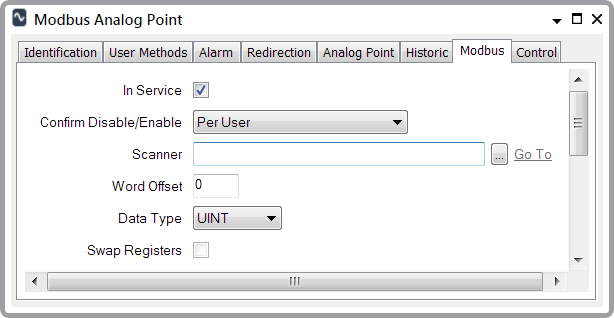Use the fields at the top of the Modbus tab to configure the Modbus-specific point properties. Some of these fields are common to many simple drivers (see Configure Common Point Properties in the Geo SCADA Expert Guide to Simple Drivers). Fields that are specific to the Simple Modbus driver are explained below:

- Word Offset—Specify the location of the point data within the Modbus register. The lowest acceptable offset is zero (see the example below).
Example:
A scanner scans several analog points on a Modbus PLC.
The scanner has this configuration:
Data Address: 10
Data Length: 12
Location: Input RegistersOne of the analog points has this configuration:
Word Offset: 7
The analog data is stored as a 16-bit value.
The configuration determines that the scanner scans registers 10 to 22 within the PLC. Within this block of registers, the analog point given above is located at register 16. (Each register is one Word.)
If the analog data was stored as a 32-bit value (see Data Type, below), the above configuration would indicate that the analog point is located at registers 16 to 17.
- Data Type—Specify how analog data is represented in the Slave. Choose from:
- UINT—Unsigned 16-bit data. Each UNIT comprises 1 Modbus register.
- DINT—Signed 32-bit data. Each DINT comprises 2 Modbus registers.
- UDINT—Unsigned 32-bit data. Each UDINT comprises 2 Modbus registers.
- REAL—IEEE 32-bit single-precision floating point value. Each REAL comprises 2 Modbus registers.
- INT—Signed 16-bit data. Each INT comprises 1 Modbus register.
- DOUBLE—IEEE 64-bit double-precision floating point value. Each DOUBLE comprises 4 Modbus registers.
The Data Type you choose affects the number of registers, which you need to consider when setting the Word Offset field (above). You need to set the Word Offset to indicate the first Word (or register) of a multi-register point.
- Swap Registers—Applies to DINT, UDINT, REAL, and DOUBLE Data Types. As this data comprises two or four 16-bit Words, you can use this check box to specify the order in which the Words of data are presented in Geo SCADA Expert, and hence the value that they represent.
Clear the check box if you do not want the data in the registers to be swapped for use in Geo SCADA Expert. For multi-register data, the highest numbered register contains the most significant Word.
Select the check box if the Word values are to be swapped for use within Geo SCADA Expert. For multi-register data, the lowest numbered register contains the most significant Word.
Example 1:
An analog value has a DINT data type, and is located at registers 16 to 17 in a PLC. The Registers are not swapped.
The present value of the analog is:
Word 16 = 1
Word 17 = 0As the registers are not swapped, this results in the analog point being given a value of 1 within Geo SCADA Expert.
If the configuration was such that the registers were swapped, this would result in the analog point being given a value of 65535 within Geo SCADA Expert.
Example 2:
A DOUBLE (64-bit double precision floating point) obtains its data from Modbus registers 40010 to 40013. The registers are not swapped, therefore register 40013 contains the most significant Word. (If the registers were swapped, register 40010 would contain the most significant Word, and register 40013 the least significant.)